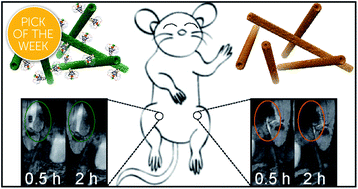Supramolecular and biomacromolecular enhancement of metal-free magnetic resonance imaging contrast agents†
Abstract
Many contrast agents for magnetic resonance imaging are based on gadolinium, however side effects limit their use in some patients. Organic radical contrast agents (ORCAs) are potential alternatives, but are reduced rapidly in physiological conditions and have low relaxivities as single molecule contrast agents. Herein, we use a supramolecular strategy where cucurbit[8]uril binds with nanomolar affinities to ORCAs and protects them against biological reductants to create a stable radical in vivo. We further overcame the weak contrast by conjugating this complex on the surface of a self-assembled biomacromolecule derived from the tobacco mosaic virus.

- This article is part of the themed collection: 2020 ChemSci Pick of the Week Collection


 Please wait while we load your content...
Please wait while we load your content...